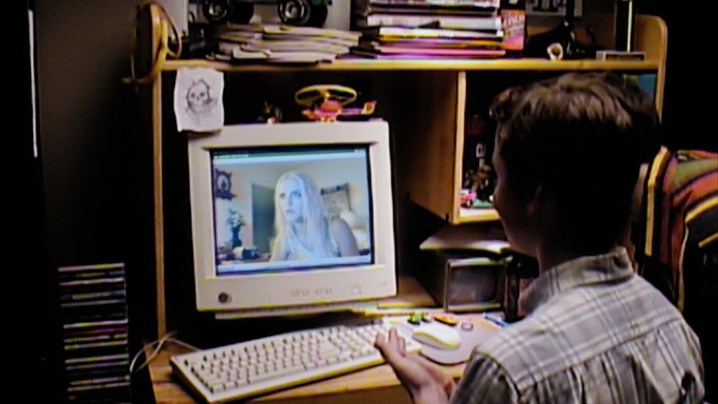2022 has been the year of horror, with a number of original theatrical movies like Smile, franchise reboots like Scream, and legacy sequels like Halloween Ends topping the box office chats and delighting fans of the genre everywhere. Streaming is no different, with Hellraiser on Hulu and Orphan: First Kill on Paramount+ finding their audiences in living rooms across America.
A new entry to 2022’s list of horror hits is V/H/S/99, the fifth entry in the young franchise that just became Shudder’s most streamed movie debut of all time. In a conversation with Digital Trends, producer Josh Goldbloom and directors Tyler MacIntyre, Vanessa Winter, and Joseph Winter talk about what makes this sequel so special and why 1999 is the ideal year to set a horror anthology in.
Digital Trends: What was the inspiration behind each of your segments for V/H/S/99?
Tyler MacIntyre (director, “Gawkers”): When Josh first approached all of us, we were given the brief that all of the stories had to be set in 1999, which brings to mind certain anxieties and traumas. We started brainstorming what was going on at that time, like the fear about Y2K, and took inspiration from the movies that were popular then like The Matrix.

For “Gawkers,” we wanted audiences to think the movie was actually made in 1999, so we used a handheld that existed back then. There was a lot of support from the producers for us to be as faithful to the period as possible: the clothes, the slang, the attitude. They may be out of style, but back in ’99, it was what was current.
Joseph Winter (director, “To Hell and Back”): For “To Hell and Back,” we wanted to find something that maybe could set ours apart from the other shorts. We shot in Utah because the landscapes are really unique there.
I feel like you guys had the toughest task in that you had to create an entire dimension (hell), and you had to make it believable. How did you pull that off?
Vanessa Winter (director, “To Hell and Back”): Honestly, it was just a small crew in the middle of the desert at night with our iPhones figuring out how could we make this look as big as possible with very limited resources.
Joseph Winter: The actual shooting location was really, really small. Also, if you’re there during the day, it’s pretty mundane. But at night, it photographs differently. It’s just one little canyon with some side valleys, but with the right cameras and at the right time, it can be a vast hellscape.

I like how “To Hell and Back” utilizes practical special effects, which you don’t see in horror movies that much anymore. What went into envisioning what the occupants of Hell would like, and how did you execute that vision?
Vanessa Winter: We really decided to lean into the earthy landscape version of hell and just make it very tangible. The idea that these creatures could be living in this actual location would make your imagination fill out the stuff that you weren’t seeing.
I think a lot of credit should be given to our creature designer Troy Larson, who is just so amazing. He brought a lot of style and personality to each of the creatures he created, but I think creating the landscape was paramount for us.
Joseph Winter: We also wanted to show a societal structure in Hell through each creature’s physical features. If you saw a creature, it’s not enough that they look cool; there had to be something about them that looked like maybe they are very low or high on Hell’s social structure.
There’s a character that has a shackle that’s been broken, which implies that there’s a slave level and that’s their place in Hell’s hierarchy. So, that was our way of cheating and making it seem like it was actually a real society.
Just as scary but in a totally different way is “Gawkers.” A large part of why it’s so effective is how real it feels. I honestly believed I was watching found footage from two decades ago, because the young male protagonists looked and acted like teenagers from 1999. What kind of research went into making that accurate to the period, so it could provide a good setup for the horror story that you’re telling?

Tyler MacIntyre: We looked at what was popular in the culture back then. The music was really energetic, but also kind of terrible, you know? The big hits at the time, like American Pie and similar teen sex comedies, haven’t aged that well. When you watch them now, they come across as weird and uncomfortable.
I thought that was ripe for satire, but at the same time, I wanted it to feel real and introduce the teenagers’ awful behavior slowly. You meet these characters, and they’re like your typical late ’90s male teenage friends, and then things get a little riskier, a little grosser, a little weirder, and a little heavier. I think there’s something to showing this unchecked, shitty male energy that was around at that time, like at Woodstock ’99 or even Columbine.
Josh, you joined the VHS franchise with 94 as a producer. V/H/S/99 is the fifth one in the series. What is it about this one that is different from the previous versions?
Josh Goldbloom (producer): Oh, that’s a good question. With V/H/S/99, we really wanted to lean into what we thought people enjoyed so much about 94. We really want people to have fun with the movie.
Back in 1999, when The Blair Witch Project came out, everybody thought it was actually real. Nobody believes the V/H/S movies are real anymore, so let’s have fun with monsters and support the filmmaker’s creative vision. I think what you get out of that is something that’s just very raw, wonderfully creative, fun, and engaging. For us, V/H/S/99 is a step forward from 94 in that we wanted to create complete lunacy.
What does the future hold for the V/H/S franchise?
Josh Goldbloom: We can take it anywhere. It’s humbling to know that we had the opportunity to create the fifth entry into a franchise. I don’t think we ever want the franchise to go stale. We want it to be as exciting for us as it is for the audience. We always joke about potential ideas like V/H/Xmas or V/H/S in space.
The possibilities are endless. We can go underwater or go back to medieval times. It doesn’t matter if there were no cameras back then. I think the sky’s the limit with the future of the franchise. I think you never want to overdo it. There are a lot of creative minds behind these projects. We’re always contemplating different ways for where this franchise could go.
V/H/S/99 is currently streaming on Shudder.
Editors' Recommendations
- 7 underrated action movies from the 1990s you need to watch
- Joe Begos makes the yuletide bloody again with Christmas Bloody Christmas
- Slash/Back director talks homegrown horror and the film’s amazing score
- Director Ti West discusses the making of Pearl, his horror prequel to X
- Speak No Evil director on making a horror movie about being too damn nice




